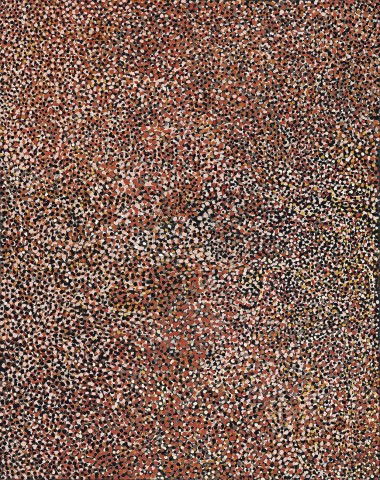ENDUNGA, 1989
EMILY KAME KNGWARREYE
synthetic polymer paint on linen
148.0 x 117.5 cm
bears inscription verso: artist’s name and Delmore Gallery cat. D131
Commissioned by Delmore Gallery, via Alice Springs in November 1989
Coventry Gallery, Sydney
Private collection, Sydney
Private collection, Melbourne
Emily Kngwarreye, Coventry Gallery, Sydney, 8 May – 2 June 1990 (illus. front cover of exhibition brochure)
This work is accompanied by a certificate of authenticity from Delmore Gallery, via Alice Springs
Awelye, 1989 – 90, synthetic polymer paint on canvas, 140.0 x 72.0 cm, in the Holmes à Court collection, Perth, illus. in Carrigan, B., Utopia: Ancient Cultures New Forms, Heytesbury Pty Ltd and The Art Gallery of Western Australia, Perth, 1999, p. 40
Endunga, 1989 – 90, synthetic polymer paint on canvas, 121.5 x 90.0 cm, in the collection of Art Gallery of Western Australia, Perth, illus. in Carrigan, B., Utopia: Ancient Cultures New Forms, Heytesbury Pty Ltd and The Art Gallery of Western Australia, Perth, 1999 p. 41
The exhibition, A Summer Project; Utopia Women’s Paintings (The First Works on Canvas-1988-89) was held at the S.H. Ervin Gallery, Sydney in April 1989. Coordinated by the Central Australian Aboriginal Media Association (CAAMA) in Alice Springs, the exhibition was the culmination of the second special project initiated the previous year when eighty-one canvases of the same size were supplied to the artists of Utopia. By the time the exhibition took place, all works had been acquired by the Holmes à Court Collection in Perth. The exhibition featured Emily Kame Kngwarreye’s earliest paintings on canvas that were made during the summer of 1988 – 89 and her painting, Emu Woman, 1988 – 89, appeared on the cover of the exhibition catalogue.
180103 EMILY - COVENTRY GALLERY COVER.jpg

BROCHURE FEATURING ‘ENDUNGA’,
Endunga, 1989 was painted on Delmore Downs Station in November 1989 and was included in the artist’s solo exhibition held at Coventry Gallery, Sydney in 1990. In many ways, Endunga echoes Emu Woman in style and subject. It features an underlying meandering linear pattern which is based on the underground growth of yam roots, together with stylised emu tracks that are infilled and over-painted with patterns of dotting that represents the fruit, seeds (Ntang) and reedy strands of the Endunga grass.
The related story tells how the Old man Emu, whose tracks underpin this painting, shepherds his chicks to rich feeding areas where they feast on the flowers, grasses and seeds of the Endunga. As their father who sat on the eggs, he has a close relationship with the young and is responsible for the vulnerable hatchlings, keeping them close by for many months and protecting them from falling prey to predators.1
Emily Kame Kngwarreye spent a lifetime making art, whether for ceremony, painting the bodies of women in her role as a ceremonial leader, as a prominent member of the Utopia Women’s batik movement or in the later years of her life, satisfying the unprecedented demand for her paintings following the successes of her early exhibitions. She is undoubtedly one of Australia’s greatest painters of the twentieth century.
1.Taken from information included in the accompanying certificate from Delmore Gallery
CRISPIN GUTTERIDGE
Emily Kame Kngwarreye lived and worked in Utopia, Northern Territory
language group: Anmatyerre/Alyawarr
SELECTED EXHIBITIONS
2008 Utopia: The Genius of Emily Kame Kngwarreye, National Museum of Art, Osaka, Japan; National Art Centre, Tokyo, Japan; National Museum of Australia, Canberra
1998 Emily Kame Kngwarreye: Alhalkere, Paintings from Utopia, Queensland Art Gallery / Gallery of Modern Art, Brisbane; Art Gallery of New South Wales, Sydney; National Gallery of Victoria, Melbourne
1997 Fluent – Emily Kame Kngwarreye, Yvonne Koolmatrie, Judy Watson – XLVII Esposizione Internationale D’Arte, 47th Venice Biennale, Venice, Italy
1996 The Eye of the Storm: Eight Contemporary Indigenous Australian Artists, National Gallery of Australia, Canberra; Museum of Contemporary Art, Sydney
1995 Stories: A Journey Around Big Things: Work by 11 Aboriginal Artists, The Holmes à Court Collection, Sprengel Museum, Hanover, Germany; Museum für Volkerkunde zu Leipzig, Leipzig, Germany; Haus der Kulturen der Welt, Berlin, Germany; Ludwig-Forum für Internationale Kunst, Aachen, Germany
1993 Tjukurrpa: Desert Dreamings: Aboriginal Art from Central Australia (1971 – 1993), Art Gallery of Western Australia, Perth
1993 Aratjara: Art of the First Australians, Kunstsammlung Nordrhein-Westfalen, Dusseldorf, Germany; Hayward Gallery, London, UK; Louisiana Museum, Humlebaek, USA
1992 Crossroads – Toward a New Reality: Aboriginal Art from Australia, The National Museum of Modern Art, Kyoto, Japan; The National Museum of Modern Art, Tokyo, Japan
1989 A Summer Project: Utopia Women’s Paintings, S.H Ervin Gallery, Sydney; and touring regionally
SELECTED LITERATURE
Neale M. (ed.),Utopia; The Genius of Emily Kame Kngwarreye, National Museum of Australia and The National Museum of Art, Osaka, 2007
Neale M., Emily Kame Kngwarreye: Alhalkere, Paintings from Utopia, Macmillan Publishers, Melbourne, 1998
Isaacs, J., Smith, T., Ryan, J., Holt, D., and Holt,J., Emily Kame Kngwarreye Paintings, Craftsman House, Sydney, 1998
Perkins, H., (et al.), Fluent – Emily Kame Kngwarreye, Yvonne Koolmatrie, Judy Watson – 47th Venice Biennial, The Art Gallery of New South Wales, Sydney, 1997
SELECTED COLLECTIONS
Art Gallery of New South Wales, Sydney
Art Gallery of South Australia, Adelaide
Art Gallery of Western Australia, Perth
Auckland City Art Gallery, Auckland, New Zealand
Museum and Art Gallery of the Northern Territory, Darwin
Museum of Victoria, Melbourne
National Gallery of Australia, Canberra
National Gallery of Victoria, Melbourne
Parliament House Art Collection, Canberra
Queensland Art Gallery / Gallery of Modern Art, Brisbane
The Vatican Collection, Rome, Italy
